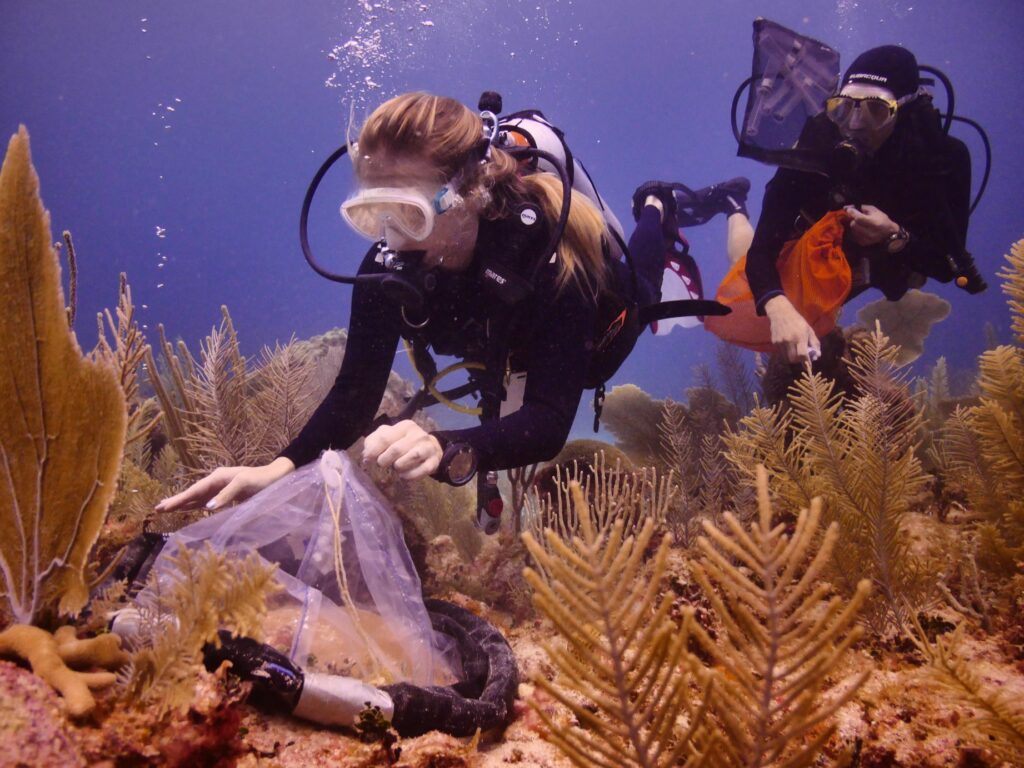Tracking Calcification: a new method for measuring reef restoration ‘success’
The urgency of the coral reef crisis calls for improved evaluation metrics and assessment techniques such that coral restoration efforts can be refined to increase efficacy and successful outcomes. There is a critical need to accurately track reef restoration progress, but evaluation is challenging due to the time scales at which corals grow and the logistics of long-term monitoring. Also, the methods used for current assessments often rely on in-water surveys by divers or remotely operated technologies, and these top-down assessments do not directly measure coral reef function, but assume it is related to benthic metrics such as coral cover. Since 2019, we have been working on a project that aims to develop a novel biogeochemical approach to directly monitor changes in reef calcification to inform and enhance restoration efforts. Biogeochemical measurements of calcification are non-invasive and offer direct insight into the critical physiological processes driving reef function and growth. By measuring ratios of alkaline metals (e.g., Sr2+/Ca2+ and Mg2+/Ca2+) that organisms uptake from seawater, it is possible to identify calcification of distinct groups of calcifiers, thus providing a rapid insight into the growth and maintenance of reef structure.
Understanding the Importance of Calcification
Calcification is a critical process through which corals and coralline algae build their calcium carbonate skeletons, forming the structure of a coral reef. It is the fundamental foundation supporting the ecological function and services that coral reefs offer. However, the decreasing rates of calcification associated with changes in reef communities pose a significant threat to the persistence of coral reefs and the benefits they provide to us humans.
The Challenge of Reef Restoration Assessment
Conserving and restoring damaged reefs is vital, but assessing the success of conservation and restoration efforts can be complex. Current methods often rely on labour-intensive manual surveys, making them costly and logistically challenging. Additionally, they focus on individual coral transplant survival, which doesn’t always correlate with the restoration of ecological function. Methods differ between restoration projects, meaning that it is difficult to compare outcomes. This lack of a standardised measurement for restoration success makes it difficult to compare outcomes between different sites and methods.
Introducing a Novel Approach: Biogeochemical Measurements

To address these challenges, researchers propose a game-changing method for assessing reef restoration outcomes – using biogeochemical measurements of seawater chemistry to measure calcifcation rates of different functional groups. The methods is non-invasive, as metabolic processes are measured from changes in the surrounding seawater chemistry, without disturbing live organisms.
Coral Reef Calcifiers
By analyzing seawater samples for carbonate chemistry changes, researchers can directly measure the calcification taking place on a coral reef. This information provides valuable insights into subtle, high-resolution changes in calcification rates over time, from individual organisms to entire ecosystems. It’s a simple, non-invasive, and cost-effective way to monitor the health of restored coral communities.
My current project aims to develop a method which can distinguish the contributions of different coral reef calcifiers to changes in seawater chemistry. Two major functional groups, scleractinian corals, and crustose coralline algae (CCA), play unique roles in the reef ecosystem. While corals are exceptional builders of CaCO3 structure, CCA provide essential support for healthy coral populations and are also critical to reef function. Current methods of quantifying calcification using the total alkalinity anomaly provide a measure of overall community calcification, but do not tease out which organisms are responsible for calcification. By measuring the uptake of alkaline metals from seawater, at the same time as change in total alkalinity, it is possible to see how much of the community calcification is due to coral vs. algae dominance. This has the potential to assist reef restoration monitoring as a rapid, cost-effective tool for quantifying reef growth in real time.
This approach to data collection, will support restoration site selection, reef health monitoring, and coral transplant growth tracking. The findings from this study will contribute to the urgent global effort to preserve and protect coral reefs in the face of a changing climate.
Check out my blog for the latest updates on this project!


